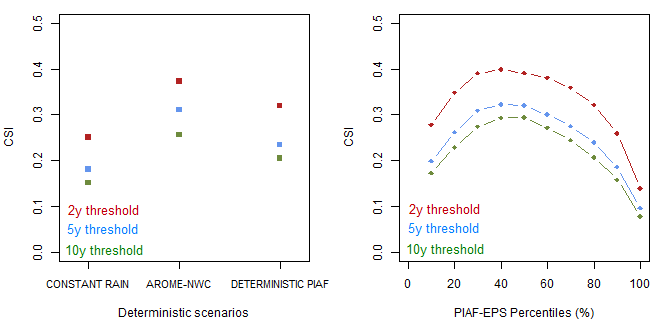Another case for ensemble flood forecasting: Insights for the French flash flood warning service
By Juliette Godet
This blog post is based on a paper we published in 2023 in Natural Hazards and Earth System Sciences. It’s a special one for me because it’s my very first research article, which also synthesizes my master’s thesis. In this study, we explored how the French national flash flood warning service could benefit from using ensemble meteorological forecasts.
First, a bit of background on flood forecasting in France. The main rivers (covering nearly 23,300 km of river network) are monitored by 17 local forecasting services, all part of the “Vigicrues” public information service on flood risk. The approaches they use can vary quite a bit, especially when it comes to hydrological/hydraulic modeling and meteorological inputs. But generally, there is a trend towards using probabilistic forecasts more systematically (Belleudy et al., 2024).
Smaller rivers that are not covered by Vigicrues can be eligible to the national flash flood warning service, Vigicrues Flash (see Figure 1). This system uses a simplified hydrological modelling method that compares simulated discharges with reference discharge quantiles to gauge flood severity. The output is pretty straightforward: it tells you whether or not a certain threshold will be exceeded, so it is deterministic in nature.

Figure 1 : Rivers monitored by Vigicrues (purple) and Vigicrues Flash (pink) in June 2020 (Piotte et al., 2020)
While the benefits of probabilistic forecasts for flood prediction are well-established, we believe that transitioning the French flash flood warning service to this approach would also be a game-changer.
In our study, we compared a probabilistic forecast developed by Météo-France, called PIAF-EPS, which is especially suited for flash floods (check out my article for the details!) with different deterministic rainfall products. We re-analyzed eight flash flood events that occurred in the French Mediterranean region between 2019 and 2021 using a hydrological modelling chain similar to the one in Vigicrues Flash. By applying a detailed validation method at the 1 km² pixel-scale, we showed that for the events we studied, the PIAF-EPS 30th–60th percentiles outperformed all the deterministic reference forecasts (see Figure 2) and consistently outperformed its deterministic counterpart, “Deterministic PIAF.”

Figure 2: Averaged CSI scores calculated for the eight flood event (the Critical Success Index ranges from 0 to 1, with 1 corresponding to perfect performance)
These findings suggest that ensemble rainfall forecasts should be incorporated into the Vigicrues Flash system, though further studies with robust statistical evaluations over longer periods and more high-precipitation events are needed to solidify these conclusions.
If you want to know more:
… On the original method used for the validation, or on the PIAF-EPS product, check our paper:
- Godet, J., Payrastre, O., Javelle, P., & Bouttier, F. (2023). Assessing the ability of a new seamless short-range ensemble rainfall product to anticipate flash floods in the French Mediterranean area. Natural Hazards and Earth System Sciences, 23(11), 3355‑3377. https://doi.org/10.5194/nhess-23-3355-2023
… On the operational flood forecasting systems in France and in which directions they will evolve, get yourself a good translator and check these two papers:
- Piotte, O., Montmerle, T., Fouchier, C., Belleudy, A., Garandeau, L., Janet, B., Jauffret, C., Demargne, J., & Organde, D. (2020). Les évolutions du service d’avertissement sur les pluies intenses et les crues soudaines en France. La Houille Blanche, 6, Art. 6. https://doi.org/10.1051/lhb/2020055
- Belleudy, A., Marty, R., Le Pape, E., Narbais-Jaureguy, D., & Zuber, F. (2024). Vers la généralisation de la prévision hydrologique probabiliste au sein du réseau Vigicrues : estimation, évaluation et communication. LHB. https://doi.org/10.1080/27678490.2024.2374079
September 3, 2024 at 20:08
Thank you very much – nice post & very interesting. In your conclusions you say that maybe more high-precipitation events are needed. Are there really so much more data available to do that?
September 4, 2024 at 10:52
Dear Florian,
Thank you for your question!
It’s true that the limited data availability is a challenge. The PIAF-EPS forecasts are only available from February 2019 onward. However, there’s still potential to analyze additional high-precipitation events, as well as smaller events or non-events, to ensure we aren’t generating too many false alarms.